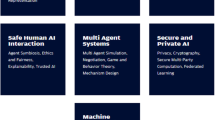Abstract
This paper proposes an adaptive learning approach that yields decision models that can be applied by a transactions agent. This model can learn effectively with a variety of data distributions. This research uses the Semantic Web as a data access approach. The Semantic Web is a method that sellers can use to publish semantically meaningful information on Websites so automated applications can reliably access that information. We implemented a Semantic Web composed of 30 vendors’ Web pages and a spider to search those pages to obtain product and vendor information. This information was used to train a learning agent, which then provided a decision model to a transaction agent.
Similar content being viewed by others
References
Albrecht, C.C., Dean, D.L., & Hansen, J.V. (2005). Marketplace and Technology Standards for B2B E-Commerce: Progress, Challenges, and the State of the Art. Information & Management, 42(6), 865–875.
Bergmark, D., Phempoonpanich, P. et al. (2001). Scraping the ACM digital library. Forum, 35(2), 7.
Berners-Lee, T. (2004). Keynote Address. The 13th International World Wide Web Conference, New York, NY. http://www2004.org/speakers.htm
Embley, D.W., & Campbell, D.M. et al. (1999). Conceptual- model-based data extraction from multiple-record web pages. Data and Knowledge Engineering, 31(3), 227–251.
Hansen, J.V., McDonald, J.B., & Turley, R.S. (2005). Partially Adaptive Robust Estimation of Regression Models and Applications. European Journal of Operational Research. (In Press)
Hansen, J.V., & McDonald, J.B. et al. (1996). A generalized qualitative-response model and the analysis of management fraud. Management Science, 42(7), 1022–1031.
Hendler, J. (2001). Agents and the semantic web. IEEE Intelligent Systems, 16(2), 30–37.
Jewell, T., & Chappell, D., (2002). Java Web Services. Cambridge: O’Reilly Press.
Libby, R. (1981). Accounting and Human Information Processing: Theory and Applications. Englewood Cliffs, NJ: Prentice Hall.
Manola, F., & Miller, E. (2004). RDF Primer. http://www.w3.org/TR/rdf-primer/
McDonald, J. & Hansen, J. (2000). An application and comparison of some flexible parametric and semiparametric qualitative-response models with heteroskedasticity. International Journal of Systems Science, 31(1), 27–34.
McDonald, J. & Newey, W. (1980). Partially adaptive estimation of regression models via the generalized t distribution. Econometric Theory. 4(3), 428–457.
Ogbuji, U. (2003). Examining one of the foremost XML business formats.http://www-106.ibm.com/developerworks/xml/library/x-think16.html
Palmer, S. (2004). Pyrple: RDF/XML, N3, and N-Triple Parser. http://infomesh.net/pyrple/
Payne, J. (1976). Task complexity and contingent processing in decision making: an information search and protocol analysis. Organizational Behavior and Human Performance 16 (August) 366–387.
Schlegel, S. (2004). ebXML: Postgraduate Report. Curtin University of Technology. http://www.schlegel.li/ebXML/postgraduate_report/www/ebxml_report.html
Shafer, K., Weibel, S., Jul E., & Fausey, J., (1996). Introduction to Persistent Uniform Resource Locators. INET96, OCLC Online Computer Library Center, Inc.
Swartz, A. (2002). The Semantic Web in Breadth. http://logicerror.com/semanticWeb-long
Wooldridge, M. (2001). An Introduction to MultiAgent Systems. Chichester, England: John Wiley & Sons.
Author information
Authors and Affiliations
Corresponding author
Additional information
James Hansen is J. Owen Cherrington Professor in the Information Systems Department of the Marriott School of Management at Brigham Young University. He is an associate editor for IEEE Intelligent Systems and Information Systems Frontiers. His research is in machine learning and planning as model checking.
James B. McDonald is Professor of Economics at Brigham Young University. His research interests are in econometrics and quantitative methods. He has recently published in Econometrica, Journal of the American Statistical Association, Management Science, and Journal of Business
Conan C. Albrecht is a professor of Information Systems at Brigham Young University. He teaches classes in enterprise development, middleware, and business programming.
Conan researches computer-based fraud detection techniques, ecommerce platforms, and online group dynamics. He has published articles on fraud detection and information theory in The Journal of Forensic Accounting, The Journal of Accounting, The Communications of the ACM, Decision Support Systems, Information and Management, and other academic and professional outlets.
Conan is currently working on an open source framework for computer-based fraud detection. The core of this research is detectlets, which encode background and detection information for specific fraud schemes. He is researching with the United Nations and the World Bank to use detectlets to prevent and detect fraud in third world countries. In the next few years, he hopes the system will serve as the foundation of a large, online repository of detectlets about all types of fraud.
Douglas L. Dean is an Associate Professor at the Marriott School of Management at Brigham Young University. He is also research coordinator for the Rollins Center for E-business. He received his Ph.D. in MIS from the University of Arizona in 1995. Dr. Dean’s research interests include electronic commerce technology and strategy, online communities, requirements analysis, and collaborative tools and methods. His work has been published in Management Science, Journal of Management Information Systems, Information and Management, The DATA BASE for Advances in Information Systems, Communications of the AIS, Expert Systems with Applications, Group Decision and Negotiation, and IEEE Transactions on Systems, Man, and Cybernetics.
Bonnie Brinton Anderson is the LeAnn Albrecht Fellow and an Assistant Professor in the Information Systems Department of the Marriott School at Brigham Young University (Provo, UT). She received her Ph.D. from Carnegie Mellon University. Dr. Anderson has published in Decision Support Systems; IEEE Transactions on Systems, Man, and Cybernetics; Communications of the ACM; Journal of Accountancy, among others. She researches in the areas of knowledge management, information systems security, and intelligent agents.
Rights and permissions
About this article
Cite this article
Hansen, J.V., McDonald, J.B., Albrecht, C.C. et al. A Semantic Web data retrieval implementation with an adaptive model for supporting agent decision structures. Electron Commerce Res 7, 5–16 (2007). https://doi.org/10.1007/s10660-006-0060-1
Issue Date:
DOI: https://doi.org/10.1007/s10660-006-0060-1




